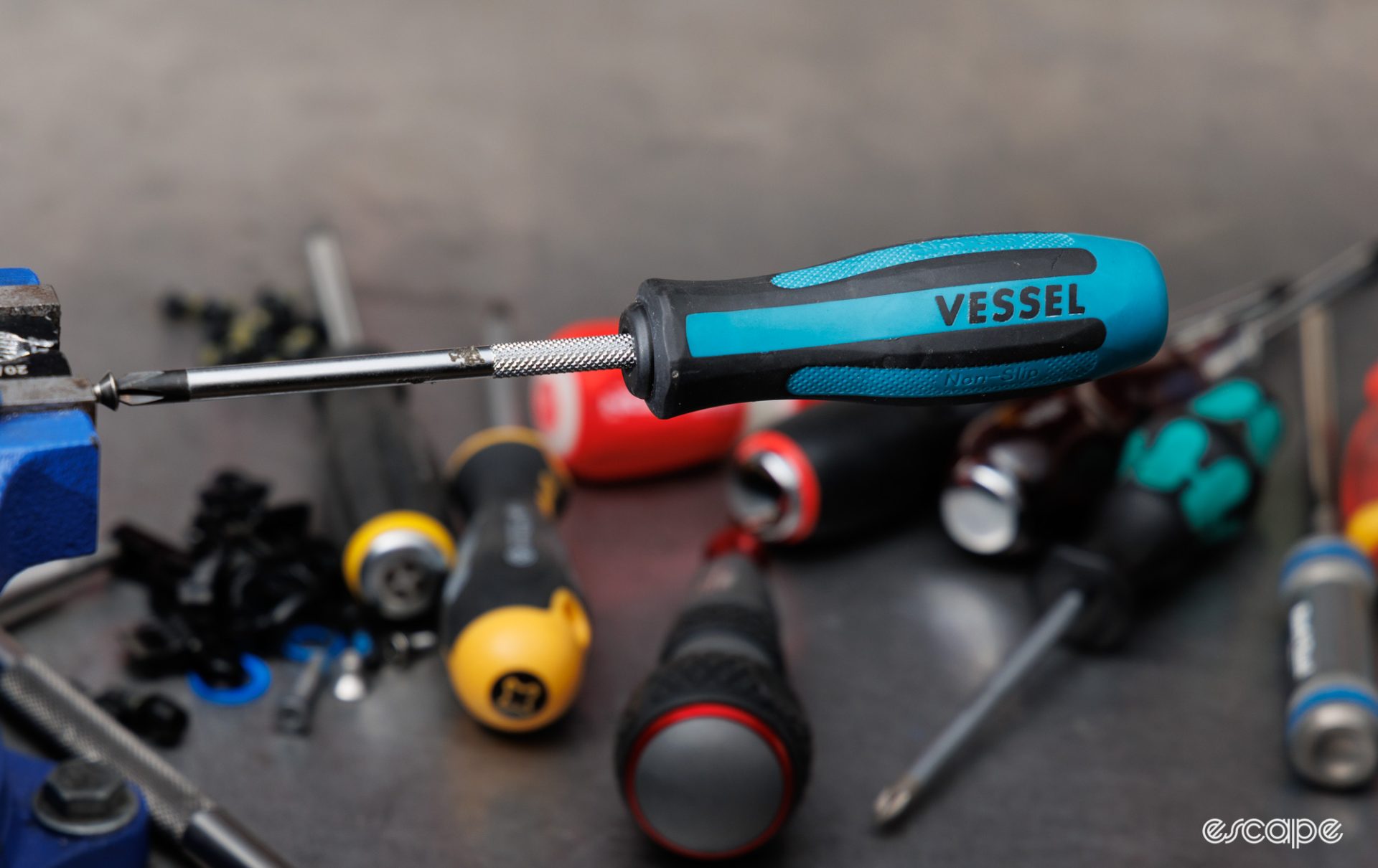Welcome back to Threaded! Since I’ve already covered my favourite hex and Torx tools, I figured I’d keep the theme of fastening turning with some thoughts about screwdrivers.
Sure, flat-head and cross-head fasteners aren’t nearly as common on bicycles as they once were, but if you own a bike from a few years ago, or one that came at a more affordable price point, then there’s a high chance you have at least a few cross-head screws to contend with. And if you’re working in a shop, they’re still an every-damn-day thing.
This article is mostly about such screws. More importantly, I wanted to further spread the word that JIS is effectively a modern-day myth. What the hell is JIS? And how the hell dare I?! This and more in this edition of Threaded.
Threaded is an ongoing series for tool nerds, DIYers, and professional mechanics. If you haven’t already, you can sign up for free to ensure you don’t miss future editions.
Phillips vs JIS
Compared to the common slotted (aka flat-head) screw before it, the now ubiquitous Phillips screw head came about in the 1930s with its recessed self-aligning design aimed to speed up assembly lines and reduce human error. Unfortunately, that same self-aligning element means the tool comes out of the screw just as easily, or in other words, it doesn’t take much torque for it to cam-out. This easy cam-out is thought by many to be a purposeful torque-limiting feature, but history suggests it was an unintentional limitation and only later used as a selling point.
Whether done to skirt the Phillips patent or improve the design, the Japanese Industrial Standard (JIS) came about in the 1950s. With a more squared geometry and blunter tip, the JIS cross-head screw allowed for more torque without any notable disadvantage. And in the ensuing decades, most cross-head fasteners on Japanese-made products were JIS. With JIS fasteners looking almost identical to a Phillips, some, but not all, offer a small dot or cross next to the recessed cross-head as an identifier.
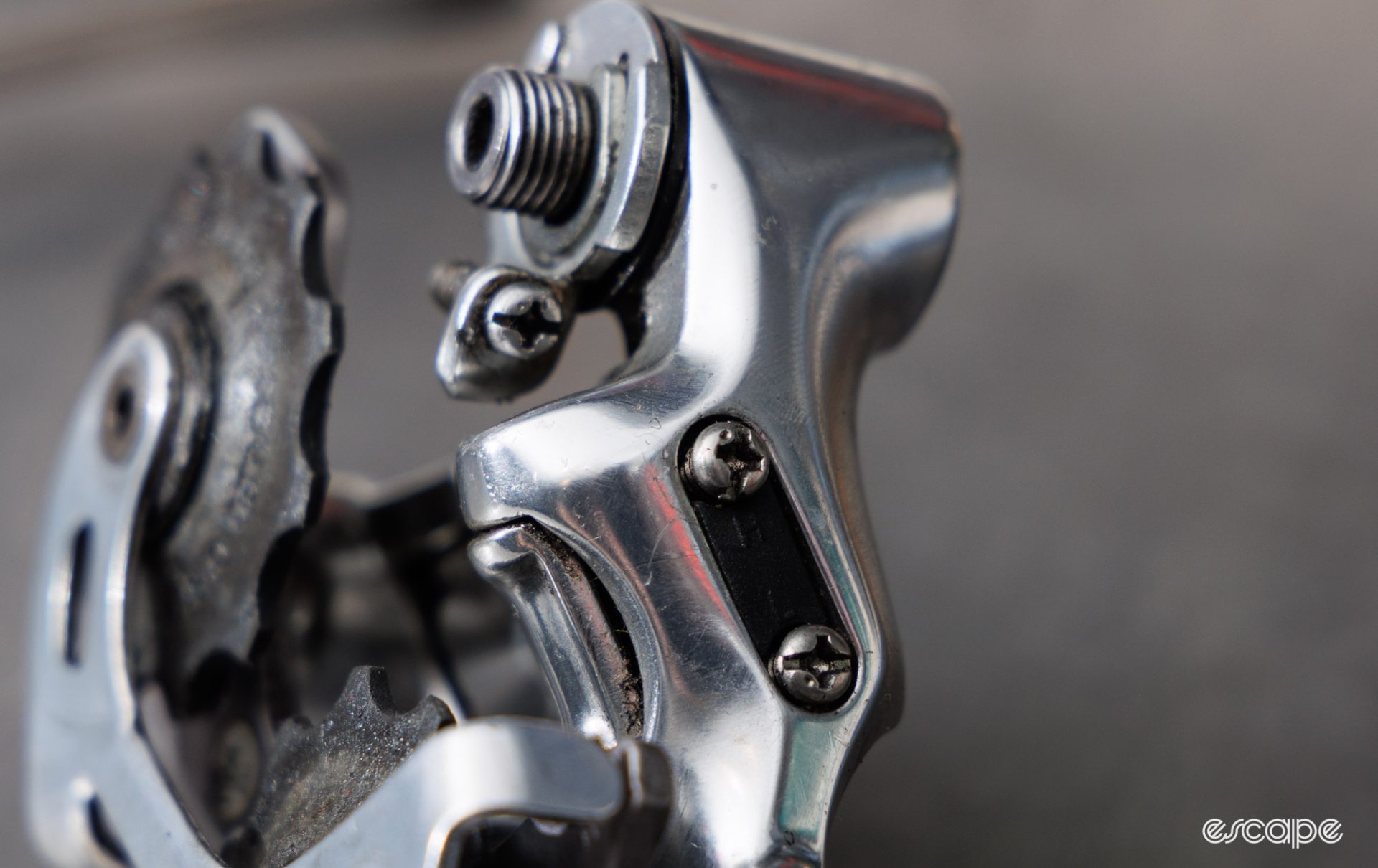
Using a traditional Phillips screwdriver in a JIS screw will lead to a sloppy fit and easy cam-out. This is largely because the sharp end of the tool prevents the vertical slots from sitting in the fastener fully. If you’ve ever made a mess of older Shimano limit screws, you were likely using the wrong drive system. Meanwhile, using a JIS screwdriver in a traditional Phillips head often improves the fit. So JIS is the answer, right? Well, yes, but also not anymore.
It was nearly a decade ago at BikeRadar that I wrongly spread the word that everyone should own a JIS screwdriver. I was right in that a lot of Shimano components from yesteryear had JIS screws, but I was wrong in that you needed a specific JIS screwdriver not to round them. Rather, you need a screwdriver that meets modern international standards for Phillips.
International standards have been in place for over two decades to unify cross-head hand tools. Today, the DIN ISO 8764-1:2006 standard lays out sizing and dimensions for Phillips (and Pozidriv) that are extremely similar to the JIS standard. Basically, if you’re looking for a JIS screwdriver today, then a modern ISO-compliant Phillips (PH) is it. And if your Phillips screwdrivers have a sharp point to them, then the sole mission of this article is to get you using a better tool.
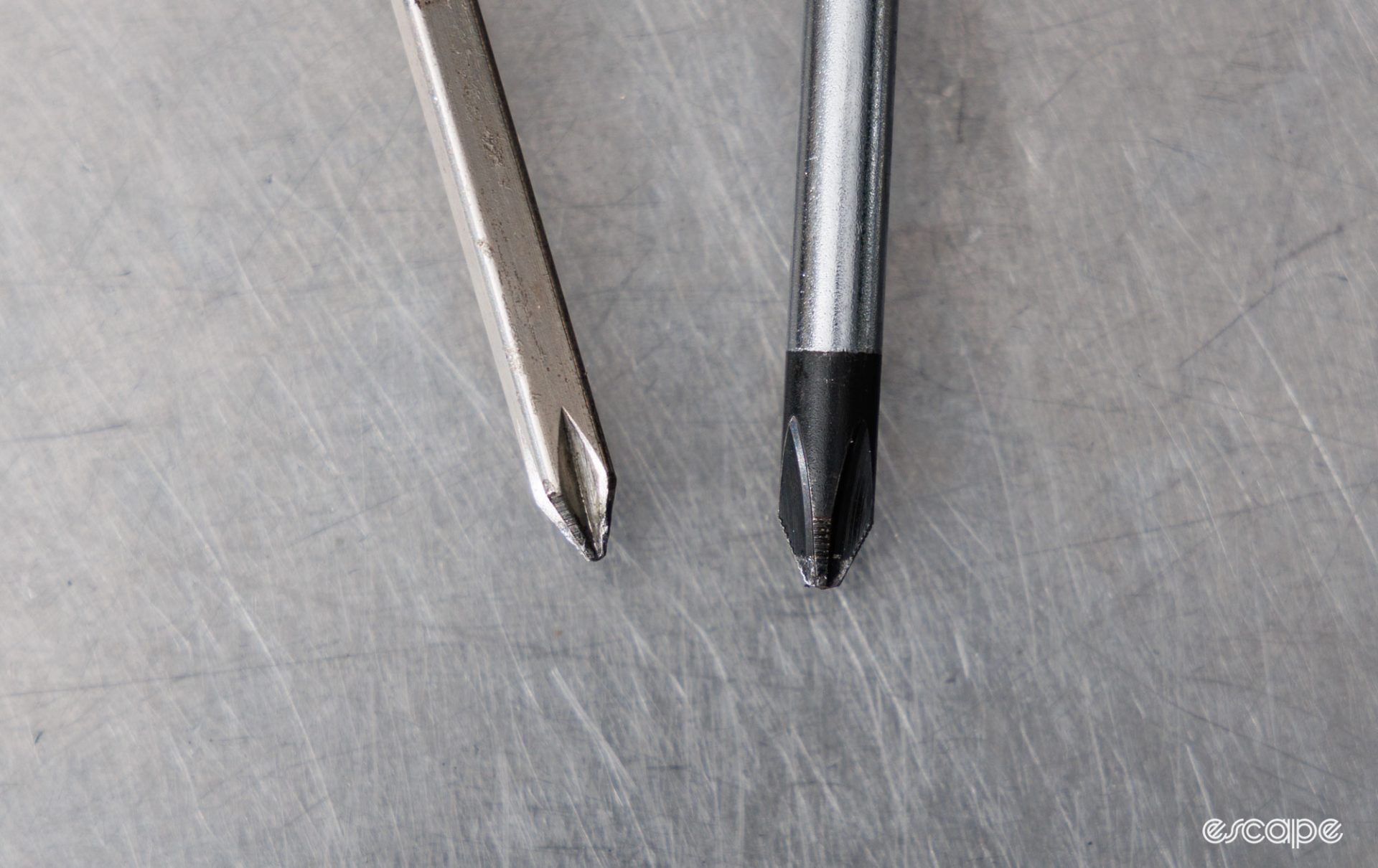

Much like the Wild West of road tubeless, brands aren’t legally required to adhere to the international standard. As a result, a mix of tools in the market will give you varying quality of fitment in a fastener. Most quality tools, at least those from big European or Japanese brands, are now typically made to these new standards. Meanwhile, some American brands are still producing outdated and sharp-pointed Phillips drivers. And just like hex and Torx keys, even brands that meet the standards still have varying security of fitment with fasteners.
And so that leads me to my favourite screwdrivers and the sizes you need …
Trial and error
The modern international standards for Phillips list sizes 0000, 000, 00, 0, 1, 2, 3 and 4 (in ascending size). These are often designated with a PH in front, so for example, a PH2 driver is a Phillips driver in a #2 size.
In my previous edition of Threaded, I wrote that it’s a common mistake to ruin fasteners with the wrong size of Torx tool. Phillips is no different, and often PH1 will turn a PH2 screw, or visa-versa – just not all that well at full torque. If you’re unsure what size is best for a given fastener, try a few sizes of screwdrivers to see which offers the most secure fit with the least wiggle.
Those smallest 0000 and 000 sizes typically exist inside electronic components or watches and aren’t commonly found on bicycles. Meanwhile, sizes 00 and 0 are also considered precision drivers, but such fasteners appear on shifter components, computers, heart rate monitors, and more.
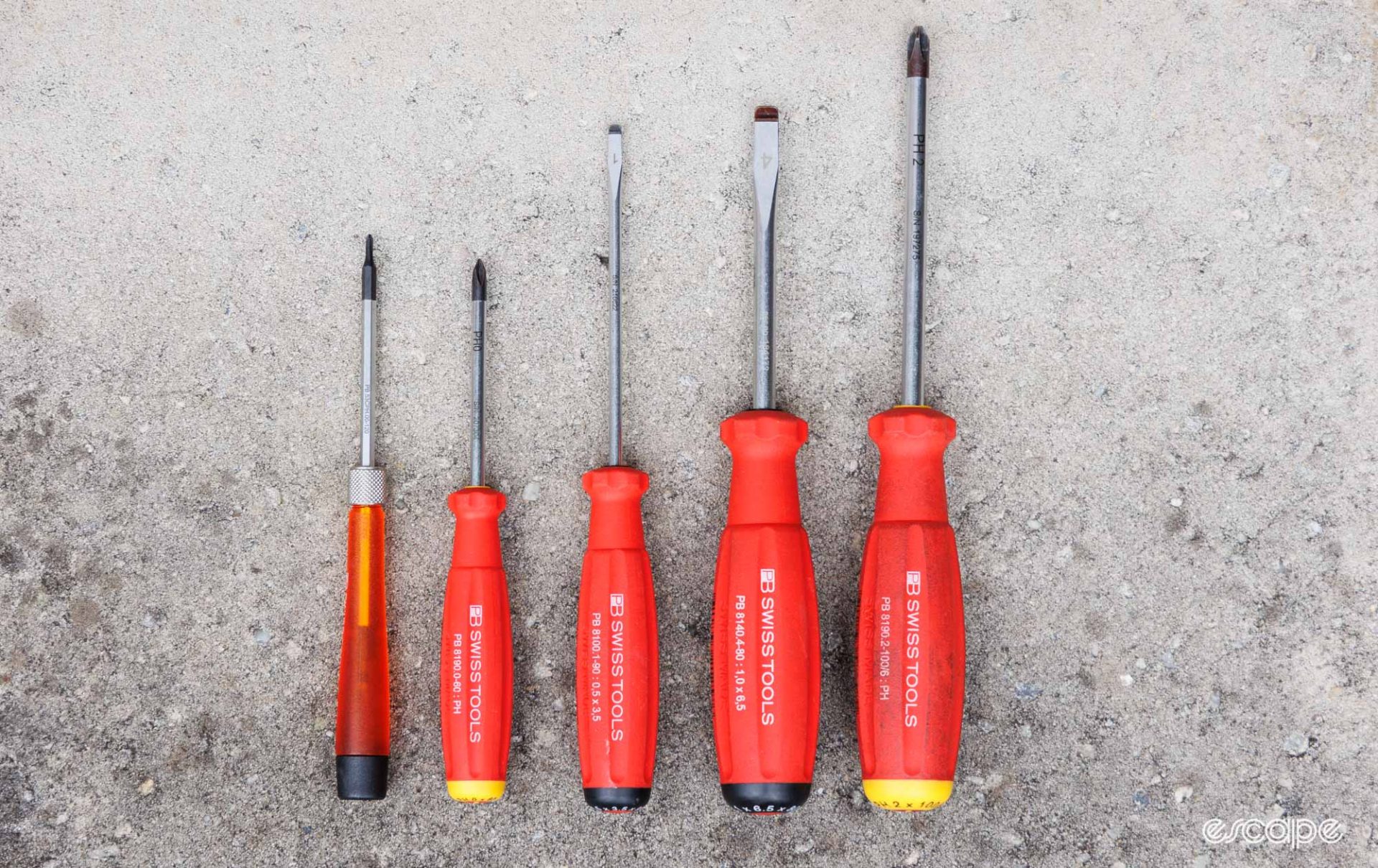
The PH1 size is another found on some lower-end shifters, on some brands of derailleurs, and anywhere else a PH2 is just that little bit too big. Often if your PH2 doesn’t fit fully into a fastener, you need a PH1.
And that brings us to the ubiquitous PH2, the one found in kitchen drawers across the globe, on your rusty multi-tool, and of course, in your toolbox. If you can only afford one quality screwdriver, make it a PH2.
Lastly, we have PH3 and PH4 sizes, which are rare in household applications and even more so on bicycles – you won’t find them in my portable cycling toolkit or on the toolboard in my workshop.
OK, so what do I use? You may see red from this repeated suggestion, but I mostly use PB Swiss. The fitment is solid, the durability is tough to beat, and the company’s Swissgrip handle ergonomics and material are my favourite.
That said, PB Swiss aren’t the only great options for Phillips screwdrivers that offer JIS-like fitment. Often incorrectly sold as JIS screwdrivers (they’re not officially anymore), the Vessel Megadora 900 is a popular pick in the bike industry and offers an incredible fitment quality, I just don’t like the handle shape or material all that much (Vessel do have other handle types, too).
Wera is a safe bet, and its laser-etched tips hold impressively well. Felo is often a great-value option with a nice handle. The American-made Park Tool driver is another with a great fit but a weirdly long blade. And the list goes on. All of these offer different fitment levels, which, depending on the fastener, can be better or worse. Ideally, you’d have a second brand of PH#1 and PH#2 to try when the fitment feels off, but that’s almost pointless if you’re sticking with the above brands.
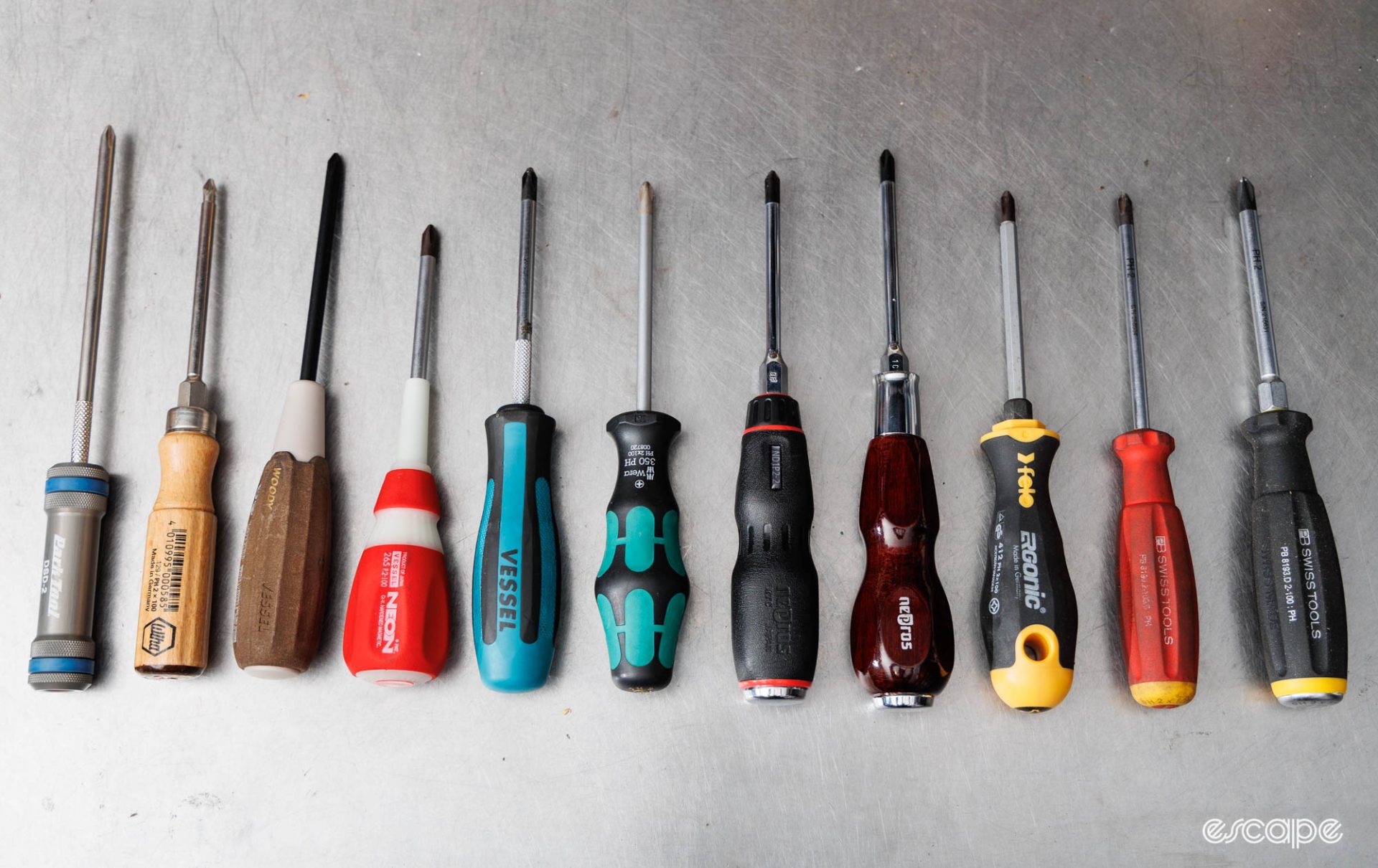
You may find a few sellers (falsely) advertising JIS screwdrivers from Japanese brands such as Vessel and Hozan, but these haven’t been JIS for years; instead, they’re modern Phillips.
Regardless of the brand, you want to find a Phillips screwdriver from the past decade or so with a flatter tip, a good reputation, and a handle shape/texture you like.
And, of course, proper technique and usage go a long way. The tips covered in my previous article apply here, too.
PoziDriv
Speaking of cross-head fasteners, I’ll briefly mention PoziDriv because, like Torx, it’s commonly misunderstood and treated wrong. PoziDriv can be identified with a faint cross machined into the top of a cross-head screw. PoziDriv is effectively to Phillips what TorxPlus is to Torx. It’s designed to reduce cam-out and increase torque application. I also think it’s designed to f*** with people a little.
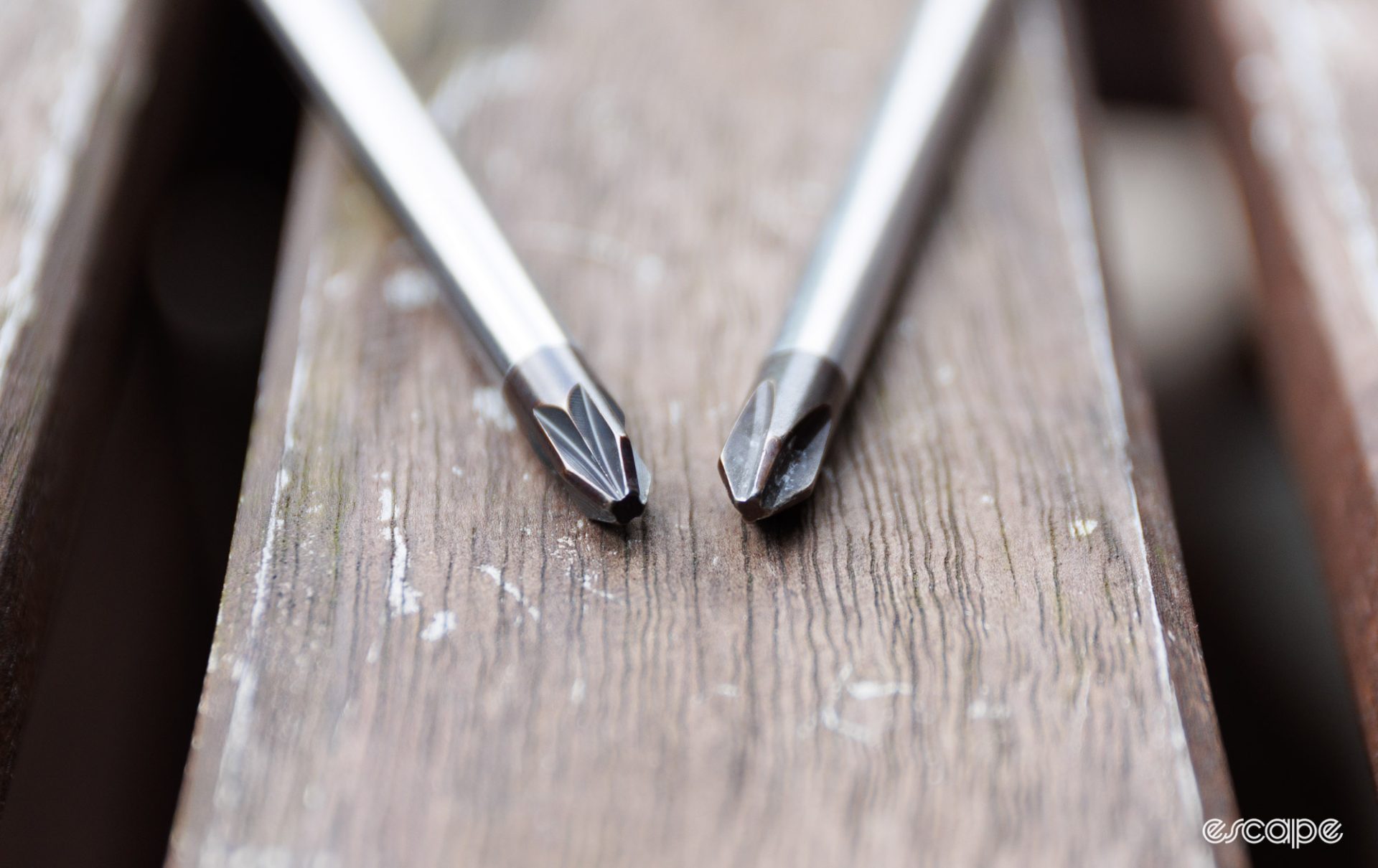
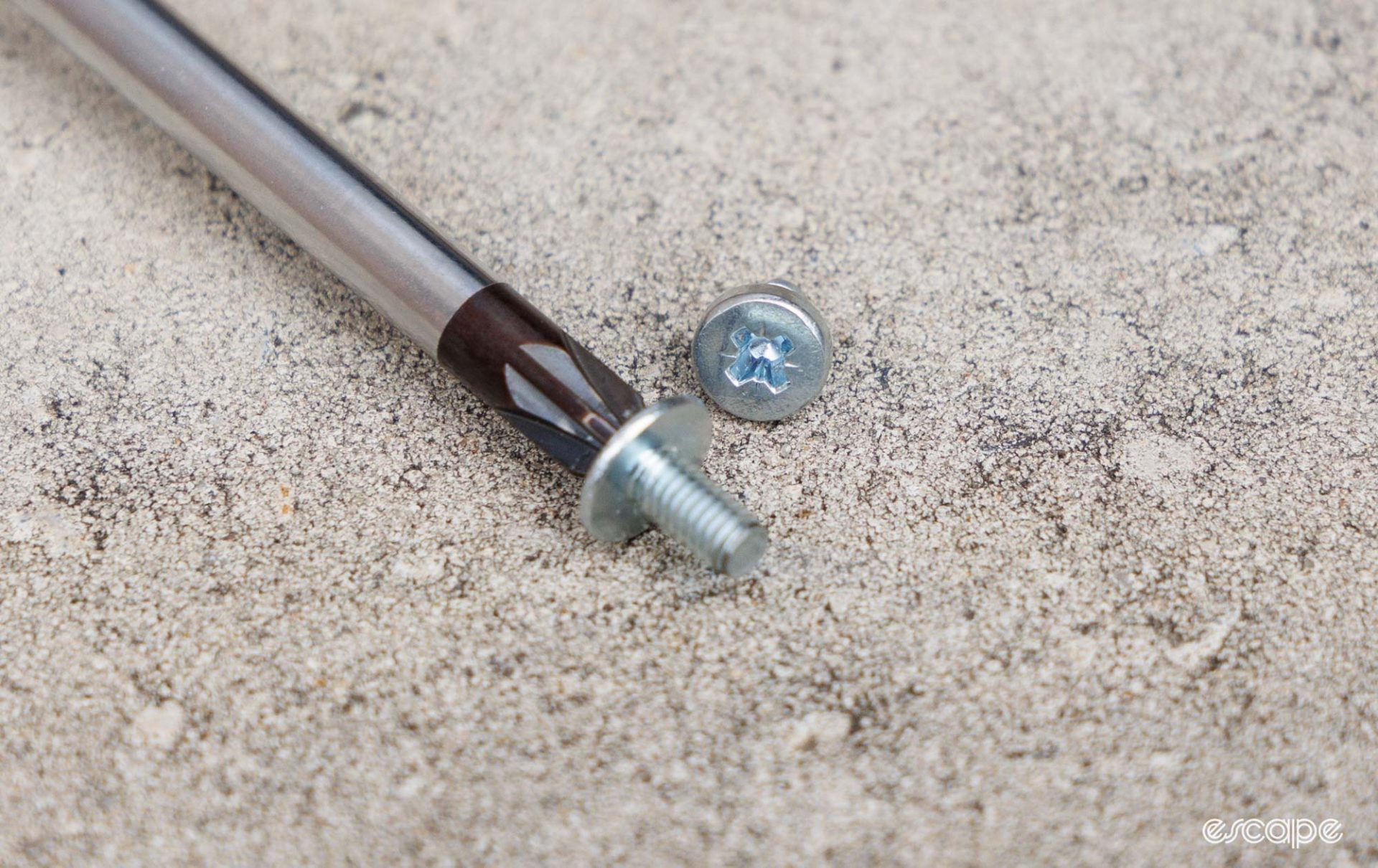
OK, so PoziDriv isn’t found on bicycles to my knowledge (unless you’re putting wood screws in places they shouldn’t be. It happens …) Still, I mention it because you know those crummy cross-headed screws on Ikea that everyone is forever caming-out? Yeah, those are Pozidriv. Get yourself a Pozidriv #2 screwdriver and build the BESTÅ Billy you can.
Oh, and be careful not to use a PoziDriv in a Phillips/JIS screw – the extra flutes will prevent proper engagement.
Flat-head / slotted screwdrivers
Perhaps even rarer on a modern bicycle is the frustrating slotted screw. However, we can thank recent generations of Shimano road disc brakes for keeping the pain alive.
Like Phillips, slotted screwdrivers have varying shapes and sizes to contend with. The big thing to know is that some slotted screwdrivers offer a parallel (aka hollow ground) tip, while most feature a tapered tip. The rarer parallel tip maximises the surface area in the fastener for a tighter fit, while tapered screwdrivers are what your father called a chisel.
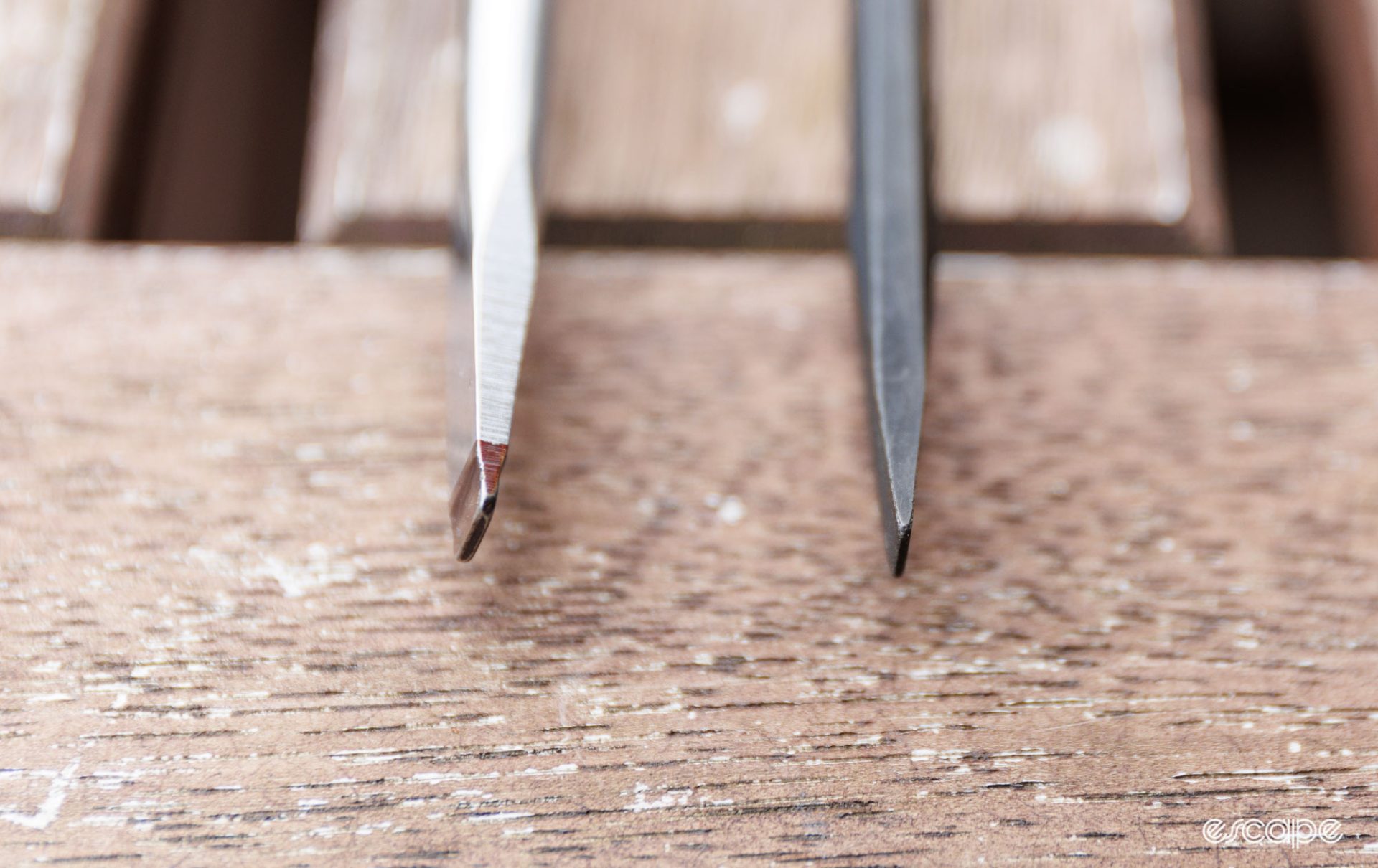

The benefit to the chisel-like tapered screwdrivers is that they are typically stronger and better able to handle the misuse such screwdrivers often receive. Because of this, parallel-tip screwdrivers remain somewhat of a specialist item, best kept for turning screws and nothing more.
Where my beloved parallel-tip screwdrivers are most obviously superior is with those blasted Shimano road disc brake pad retaining pins. So many people strip these, and many of those drilled screw heads could be prevented by using a parallel-tip driver in the right size. While not the only good option, a PB Swiss 8100.3-120 is one of the best-fitting screwdrivers I’ve tried for those pesky brake pad bolts.
However, my most-used flat-blade screwdriver is a small, cheap, generic item that’s never actually used to drive screws. Rather I scrape gunk from derailleur pulleys with it, I use it as a mini pry bar, or just for stabbing through packaging.
Other screwdrivers
Of course, a screwdriver is merely a tool that drives a screw. Technically (at least according to PB Swiss), hex and Torx keys are also screwdrivers.
I see screwdrivers as any hand tool with a straight handle inline to the tool blade. And with that, I’ll give another shout-out to hex-based screwdrivers for sizes 1.5-4 mm, and Torx screwdrivers in sizes smaller than T15.

Pro tips for self-justifying tool purchases
I’m often blamed for people impulsively purchasing new tools. Given this, I figured, why not share some pro tips that have helped me amass my collection over the years? I’ll kick things off with a question that’s relevant to screwdrivers.
How can you know your current tool is good if you don’t have a point of comparison?
Shameless plugs of the week
Since you’re here, allow me to share other content you may like. I recently wrapped up a review of the Feedback Sports Pro Mechanic and Park Tool PRS-26 repair stands. It was a close battle between these three-legged lightweights. And in case you already have an older Feedback Sports stand, you may appreciate a little tip shared.

For your ears, we’ve recently ramped up our commitment to the Geek Warning podcast. The regular (free!) episode had me explaining (ranting) why repair stands need to have an easy angle adjust feature. Meanwhile, we also launched our bonus episodes for Escape Collective members, with the first episode answering mechanic-related questions from our members. More to come!
Coming up
The to-do list for future Threaded editions is long, and at least for this tool nerd, increasingly exciting. Right now, I’ve got my hands full with ultra-budget torque wrenches, and I plan to see how they stack up against more premium options. Stay tuned, and if you haven’t already, please sign up to Threaded so you don’t miss future editions (it’s free and you’ll only get my emails).
And as a reminder, Threaded (and everything else I do at Escape Collective) is wholly and solely funded by our members. It hurts to admit, but we don’t yet have enough members to make this project as sustainable as needed. If you haven’t already, please consider becoming a member. And if you’re reading this on your lunch break with five filthy bikes still to finish today, please know that we have ultra-special rates for the professional mechanics of the industry.
Alright, till next time!
What did you think of this story?
